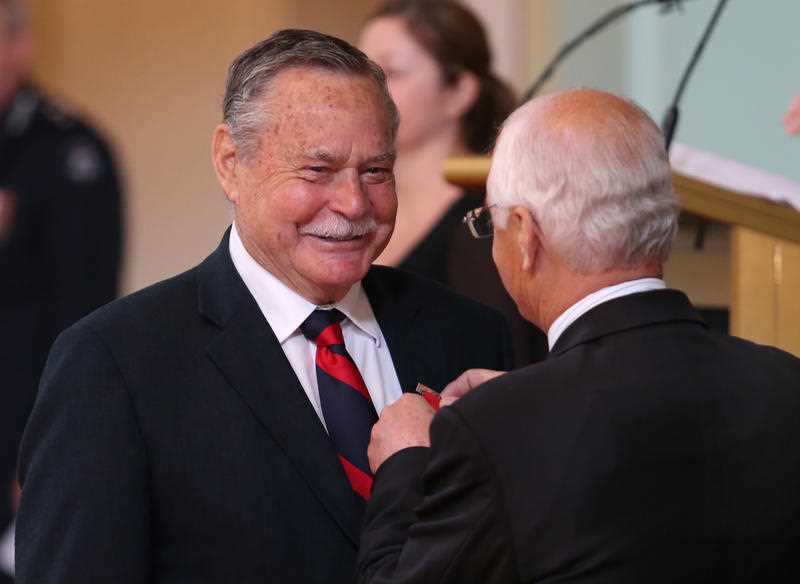In the 1940s he was a fatherless Australian Rules prodigy; in the ’50s he was one of the best players of the era; in the ’60s and ’70s he’d become a coach renowned for the colourful berating of his players, and for winning premierships.
More recently Ron Barassi is probably best remembered for pursuing a man he saw assaulting a young woman in St Kilda and tackling him to the ground.
That was on New Year’s Eve 2008 when Barassi was 72 and almost capable of such noble acts. He ended up being set upon himself and came away with broken ribs, assorted scrapes and a medal for bravery.
Ronald Dale Barassi, who has died aged 87, was officially a legend of Australian Football. One of the earliest football celebrities, he is also renowned as an innovator, an inspirational coach and a magnificent player.
Born in Castlemaine, Victoria, to Ron Barassi Snr and his wife Elza, Barassi was predestined to follow his father to the Melbourne Football Club.
Ron Snr played 58 games for the Demons and was a member of Melbourne’s 1940 premiership side.
Within days of winning that grand final, he enlisted in the army and was sent to North Africa where he was killed in action at Tobruk in July 1941 at the age of 27.
The football club pledged to look after five-year-old Ron jnr and his mum and from the age of 16, he lived in a bungalow in the backyard of the legendary Melbourne coach Norm Smith.
While Barassi was inextricably linked to Melbourne, the zoning rules that existed at the time gave Collingwood and Carlton the right to recruit him.
Melbourne duly lobbied the VFL and Barassi became the first player to come under under what became known as the father-son rule.
So it was that Barassi played his first senior VFL game for the Demons against Footscray as a 17-year-old in 1953.
Within four years he’d become vice-captain of the club, taking over the captaincy in 1960, the same year in which he and Melbourne claimed their fifth premiership in six years.
After 204 games at Melbourne, Barassi shocked the sport by accepting an offer to become captain-coach of Carlton in 1965. He played five seasons and 50 games for the Blues, delivering premierships in 1968 as a playing coach and in 1970 as coach.
Barassi retired from football after the 1971 season to concentrate on establishing his office furniture business, only to return two years later for perhaps the most colourful, controversial and successful period of his coaching career at North Melbourne.
By 1973 North was the only club in the then-VFL not to have won a premiership.
They’d finished at the bottom of the ladder with one win for the season in 1972.
But club president and former player Allen Aylett and secretary Ron Joseph decided to do something about it and devised a plan to win a premiership within five years.
Central to their plan was the “purchase” of as many top players as possible and getting Barassi to coach them.
Thanks to the introduction of a new and short-lived rule relating to player transfers, Joseph “bought” the nucleus of a new team, his recruits including three VFL captains, Barry Davis from Essendon, John Rantall from South Melbourne and Doug Wade from Geelong.
The buying spree also pulled in star interstate players such as Malcolm Blight and Barry Cable.
In the first year under Barassi, North finished sixth and in 1974 they finished second, beaten by Richmond in the grand final.
The breakthrough came the following year, with Barassi masterminding a 55-point triumph over Hawthorn in the decider.
Barassi and North’s team of champions repeated the effort in 1977, winning the club’s second flag after playing a draw with Collingwood in the initial grand final and then winning by 27 points in the replay a week later.
The win was a crowning moment to one of the game’s great careers.
Barassi went on to have brief coaching stints with Melbourne and Sydney and to enhance his reputation as one of the game’s great visionaries through his “Irish Experiment” in which he recruited several players from Gaelic football to Australian Rules, including Demons’ champion Jim Stynes.
His 10th grand final victory also led to the Barassi coining the trademark 17410 – 17 grand finals for 10 premierships – which, along with the number 31 from his football jersey, always accompanied his autograph.
In 1996 Barassi became an inaugural inductee into the Australian Football Hall of Fame, entering that pantheon as a “Legend” and in 2006 he became only the third Australian Rules footballer, along with Leigh Matthews and Ted Whitten, inducted into the Sport Australia Hall of Fame.
This week, Bob Skilton became the fourth.
Barassi was named Victorian of the Year in 2009 and is commemorated in a larger-than-life bronze statue outside Gate 4 of the MCG.
In 2012, at the age of 76, he revealed, with typical good humour, that he had dementia.
“I’m forgetful,” Barassi said. “It’s not a worry.”
Barassi married twice, first to Nancy Kellett in 1957 with whom he had Susan, Ron and Richard; and to Cherryl Copeland in 1981.
By Mike Hedge in Melbourne



